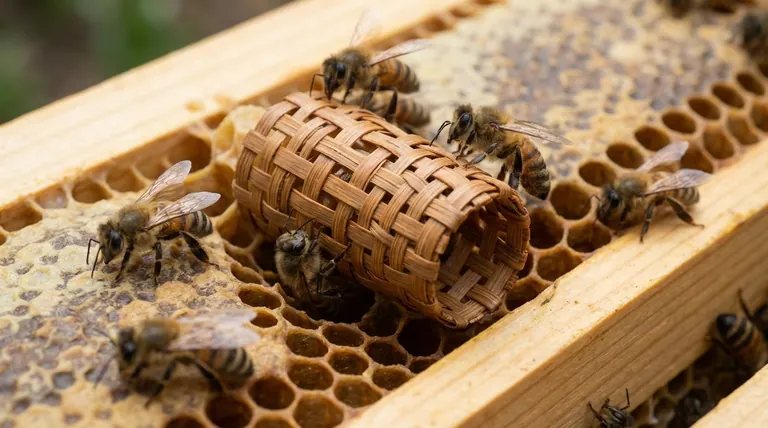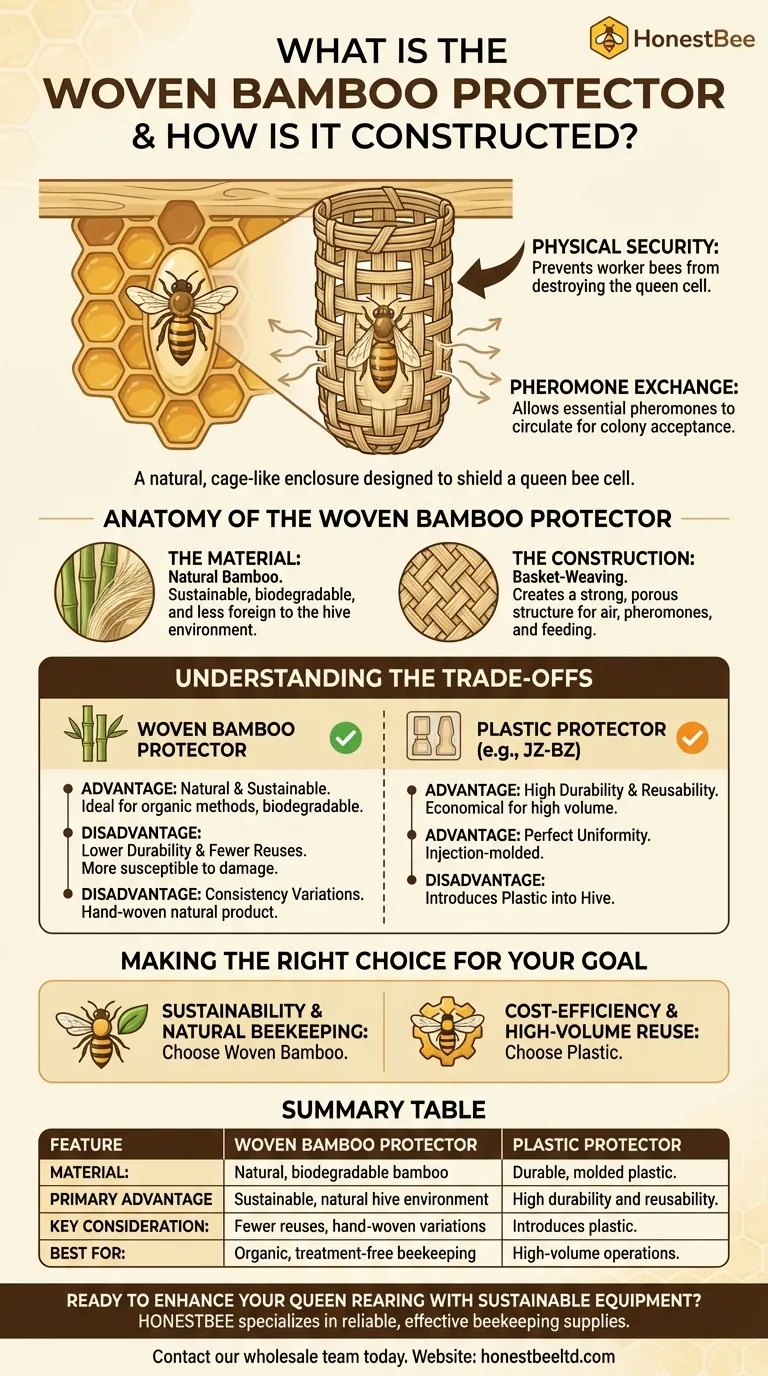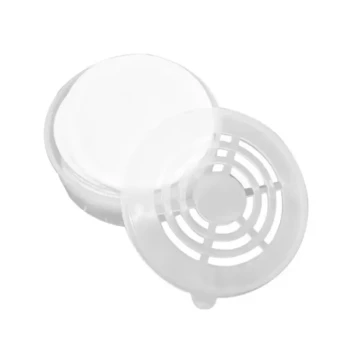At its core, a woven bamboo protector is a natural, cage-like enclosure designed to shield a queen bee cell from the colony before she emerges. It is constructed from fine slivers of bamboo that are intricately basket-woven together to form a durable yet permeable barrier. This design physically prevents worker bees from destroying the valuable queen cell while allowing her essential pheromones to circulate throughout the hive.
The woven bamboo protector offers a sustainable, natural alternative to plastic protectors. Its primary function is to ensure a new queen can safely emerge by shielding her cell, while its woven design facilitates her acceptance by the colony through pheromone exchange.

The Role of a Queen Cell Protector
To understand the bamboo protector, one must first understand the challenge of introducing a new queen. A honeybee colony is fiercely loyal to its existing queen and will often identify a new, unhatched queen cell as a foreign threat.
Preventing Premature Destruction
The primary goal of any queen cell protector is physical security. Worker bees may attempt to chew through the wax of an introduced queen cell, killing the developing queen inside. A protector forms a rigid barrier that makes this impossible.
Facilitating Acceptance
While shielding the cell, the protector must not isolate it. A new queen's acceptance depends on the colony becoming accustomed to her unique scent, or pheromone. The gaps in the woven structure are critical for allowing these pheromones to spread, signaling her presence and legitimacy to the hive.
Anatomy of the Woven Bamboo Protector
The design of the bamboo protector is simple but highly functional, leveraging both the material and the construction method to meet the specific needs of the beekeeper and the bees.
The Material: Natural Bamboo
The use of bamboo is the key differentiator. As a natural, fibrous material, it is less foreign to the hive environment than plastic. This can potentially lead to better acceptance by the bees.
Furthermore, bamboo is a sustainable and biodegradable resource, making it an attractive choice for beekeepers focused on environmentally-friendly practices.
The Construction: Basket-Weaving
The basket-weave technique creates a structure that is both strong and porous. The fine slivers of bamboo interlock to form a cage that worker bees cannot easily dismantle or chew through.
Simultaneously, the small openings inherent in the weave are large enough for air and pheromones to pass freely. They also allow worker bees to feed the virgin queen through the cage after she emerges, should she remain inside it for a short period.
Understanding the Trade-offs
While effective, the woven bamboo protector is not the only option, and it comes with a specific set of considerations compared to common plastic alternatives like the JZ-BZ style protector.
Advantage: Natural and Sustainable
The most significant benefit is its natural composition. For beekeepers practicing organic or treatment-free methods, avoiding the introduction of plastics into the hive is a major priority. Its biodegradability means it can be composted if damaged.
Disadvantage: Durability and Reuse
Bamboo, while strong, is not as durable as molded plastic. These protectors can be more susceptible to damage during insertion, removal, or cleaning. They may offer fewer reuses than their plastic counterparts, potentially increasing long-term cost.
Disadvantage: Consistency
As a hand-woven natural product, there can be slight variations in size and weave consistency from one protector to the next. Plastic protectors, being injection-molded, offer perfect uniformity.
Making the Right Choice for Your Goal
Selecting a queen cell protector depends on balancing your operational priorities with your beekeeping philosophy.
- If your primary focus is sustainability and natural beekeeping: The woven bamboo protector is the ideal choice, as it avoids introducing plastic into the hive.
- If your primary focus is cost-efficiency and high-volume reuse: A durable, easily sterilized plastic protector may be the more practical and economical option.
Ultimately, the choice of a protector is a small but meaningful decision that reflects your overall approach to hive management.
Summary Table:
| Feature | Woven Bamboo Protector | Plastic Protector (e.g., JZ-BZ) |
|---|---|---|
| Material | Natural, biodegradable bamboo | Durable, molded plastic |
| Primary Advantage | Sustainable, natural hive environment | High durability and reusability |
| Key Consideration | Potential for fewer reuses, hand-woven variations | Introduces plastic into the hive |
| Best For | Organic, treatment-free, and sustainable beekeeping | High-volume, cost-efficient operations |
Ready to enhance your queen rearing with sustainable, high-quality equipment?
As a commercial beekeeper or distributor, your success depends on reliable, effective tools. HONESTBEE specializes in supplying the beekeeping supplies and equipment you need to operate efficiently and sustainably.
Let us help you make the right choice for your apiary. Contact our wholesale team today to discuss your needs for woven bamboo protectors and other essential beekeeping supplies.
Visual Guide

Related Products
- Brown Nicot Queen Cell Cups for Breeding Queen Bees Beekeeping
- JZBZ Push-In Queen Cell Cups for Beekeeping
- JZBZ Langstroth Queen Rearing Frame for Beekeeping
- Clear Black Plain Polystyrene Queen Bee Grafting Cell Cups No Lug for Bee Queen Cup
- JZBZ Type Wide Base Plastic Queen Cell Cups for Base Mounting and Queen Rearing
People Also Ask
- What are the signs that a queen cell is about to emerge? Master the Critical Timing for Hive Success
- What should be done with extra queens from grafting? A Strategic Guide for Apiary Management
- How are the queen cells raised after removing the plugs? Master the Art of Queen Rearing
- What are the ideal conditions for raising good queen cells? Achieve Robust Queens with Strong Cell-Builder Colonies
- Why is it important to select a healthy larva less than 24 hours old for queen rearing? Maximize Queen Quality and Colony Strength



















